The smart airport market is expected to grow from USD 7.0 billion in 2025 to USD 21.5 billion by 2035, registering an 11.8% CAGR and generating an absolute dollar opportunity of USD 14.5 billion. Growth is driven by increasing passenger traffic, the need for operational efficiency, enhanced security protocols, and adoption of advanced technologies such as IoT, AI-based analytics, automated baggage handling, and biometric passenger processing.
Smart airports provide real-time data insights, improved passenger experience, and optimized resource utilization, making them an attractive investment for airport authorities worldwide. The long-term value accumulation curve illustrates the progressive accumulation of market value over the forecast period. From 2025 to 2028, value accumulation is steady, reflecting early-stage adoption in developed regions such as North America and Europe, where initial digitalization projects, regulatory compliance, and pilot implementations contribute incremental revenue. Between 2029 and 2032, the curve steepens as Asia Pacific, the Middle East, and Latin America scale up smart airport deployments to accommodate increasing passenger volumes, expand infrastructure, and integrate advanced operational technologies.
From 2033 to 2035, the curve maintains upward momentum but begins to moderate slightly as early-adopting regions reach higher penetration and incremental growth shifts toward system upgrades, replacements, and technology enhancements. The USD 14.5 billion opportunity reflects consistent long-term value accumulation, with early adoption, mid-phase acceleration, and late-stage stabilization shaping the market trajectory for smart airports globally between 2025 and 2035.

| Metric | Value |
|---|---|
| Smart Airport Market Estimated Value in (2025 E) | USD 7.0 billion |
| Smart Airport Market Forecast Value in (2035 F) | USD 21.5 billion |
| Forecast CAGR (2025 to 2035) | 11.8% |
The smart airport market is primarily driven by airport operations and management, which accounts for around 44% of the market share, as airports adopt digital technologies to improve efficiency, security, and passenger experience. The airline and ground services segment contributes approximately 25%, using smart systems for flight scheduling, baggage handling, and operational coordination. Retail and commercial services within airports represent close to 15%, integrating digital solutions to enhance customer engagement and revenue streams. The security and surveillance sector accounts for roughly 10%, implementing biometrics, AI monitoring, and access control technologies. The remaining 6% comes from air traffic management and facility maintenance, leveraging smart systems for optimized operations and infrastructure utilization. The smart airport market is evolving with innovations in automation, IoT integration, and predictive analytics. Biometric and facial recognition systems are being widely deployed to streamline passenger check-in, boarding, and security screening. AI-powered baggage handling and predictive maintenance tools are enhancing operational efficiency. Digital signage, mobile apps, and personalized services improve passenger engagement and experience. Cloud-based airport management platforms enable real-time data analysis and integrated decision-making. Partnerships between technology providers, airport authorities, and airlines are expanding the deployment of advanced solutions. Growing passenger traffic, focus on operational efficiency, and demand for seamless travel experiences are driving adoption globally.
The Smart Airport market is experiencing accelerated growth as airports worldwide increasingly adopt digital, automated, and software-driven solutions to enhance operational efficiency, passenger experience, and security. The market is currently being shaped by the deployment of intelligent technologies that enable predictive maintenance, real-time monitoring, automated check-in, and advanced baggage handling. Increasing investments in airport modernization and expansion projects in response to rising passenger traffic are driving market demand.
The integration of IoT, AI, and cloud-based systems has allowed airports to optimize resource utilization, reduce operational costs, and provide real-time decision-making capabilities. Future growth is expected to be supported by ongoing digital transformation initiatives, regulatory requirements for safer and more efficient air travel, and the focus on enhancing passenger throughput without expanding physical infrastructure.
The ability to implement software updates and intelligent analytics over existing hardware infrastructure has positioned the market for long-term scalability As the aviation industry recovers and passenger volumes rise, Smart Airport solutions are anticipated to remain a crucial component of airport operations globally.
The smart airport market is segmented by airport size, system, airport model, operation, end user, application, and geographic regions. By airport size, smart airport market is divided into Large, Small, and Medium. In terms of system, smart airport market is classified into Software and solutions, Communication and connectivity, Endpoint devices, and Data Storage. Based on airport model, smart airport market is segmented into Airport 4.0, Airport 2.0, and Airport 3.0. By operation, smart airport market is segmented into Aeronautical and Non-Aeronautical. By end user, smart airport market is segmented into Implementation and Upgrades and services. By application, smart airport market is segmented into Terminal side, Landside, and Airside. Regionally, the smart airport industry is classified into North America, Latin America, Western Europe, Eastern Europe, Balkan & Baltic Countries, Russia & Belarus, Central Asia, East Asia, South Asia & Pacific, and the Middle East & Africa.
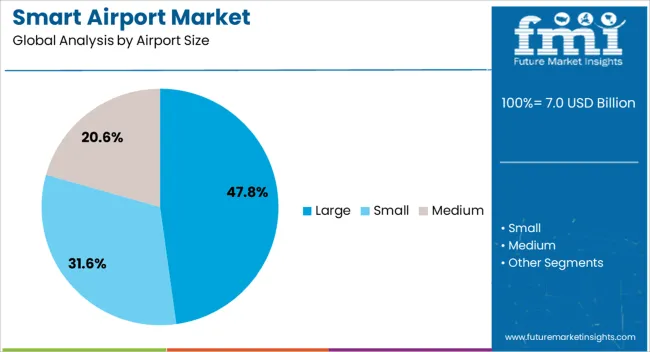
The Large Airport segment is projected to hold 47.8% of the Smart Airport market revenue in 2025, making it the leading airport size category. This dominance is attributed to the high passenger traffic and operational complexity at large airports, which necessitate advanced, integrated solutions for check-in, security, baggage handling, and terminal management.
Investments in digital infrastructure, coupled with the need for predictive analytics and automated systems, have favored the adoption of software-defined operations in large airports. Operational efficiency is enhanced through centralized monitoring, energy optimization, and real-time passenger flow analytics.
The ability to scale and integrate modular systems without disrupting daily operations has further reinforced the preference for smart solutions at large airports As global air travel continues to expand, the large airport segment is expected to remain the primary driver of market growth, supported by increasing focus on passenger satisfaction, operational resilience, and technology-enabled cost savings.
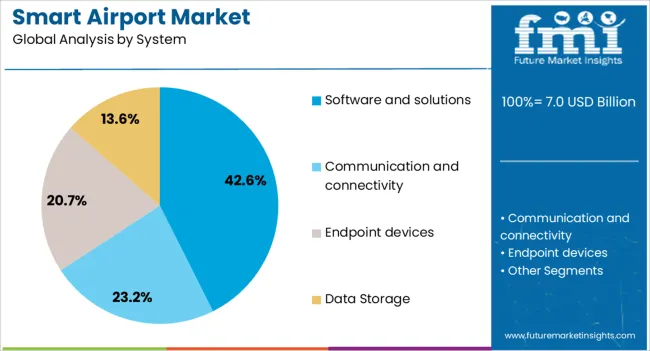
The Software and Solutions segment is expected to capture 42.6% of the Smart Airport market revenue in 2025, making it the leading system category. This prominence is driven by the flexibility and scalability offered by software-based solutions, which enable airports to implement analytics, automation, and operational optimization without extensive hardware upgrades.
Software platforms allow integration with multiple airport operations, such as baggage management, passenger processing, flight scheduling, and security systems, providing centralized control and real-time insights. The segment has grown due to increasing demand for predictive analytics, AI-driven decision-making, and cloud-based monitoring, which collectively improve efficiency and reduce operational downtime.
The adoption of these solutions is further encouraged by the need for airports to meet passenger expectations for speed, accuracy, and safety while adhering to regulatory requirements As airports pursue digital transformation, software and solutions remain the most adaptable and cost-effective approach for modernizing operations, ensuring long-term market leadership in this category.
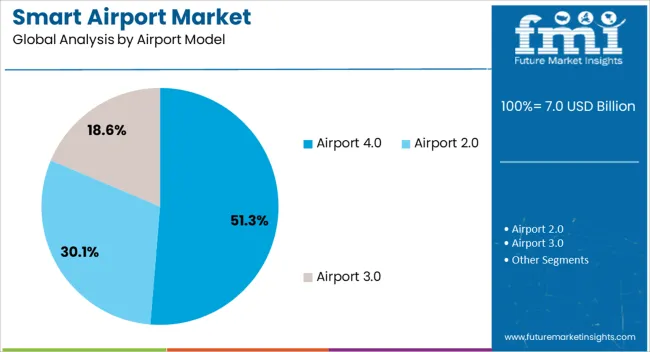
The Airport 4.0 segment is projected to hold 51.3% of the Smart Airport market revenue in 2025, positioning it as the leading airport model. Growth in this segment is being driven by the integration of advanced technologies, including IoT, AI, robotics, and cloud computing, which collectively support fully automated and interconnected airport operations.
Airport 4.0 facilitates predictive maintenance, real-time monitoring, and seamless passenger experiences through digital self-service kiosks, automated security, and smart baggage handling. Its adoption is fueled by the need to handle increasing passenger volumes efficiently while maintaining high standards of safety and operational reliability.
The modular and software-centric architecture of Airport 4.0 allows continuous upgrades and integration of new technologies without disrupting ongoing operations As airports globally focus on modernization and operational intelligence, Airport 4.0 has emerged as the preferred model, offering scalable, cost-efficient, and high-performance solutions that address both passenger expectations and operational complexities in a rapidly evolving aviation landscape.
The smart airport market is expanding due to growing air passenger traffic, airport modernization initiatives, and adoption of automation and digital technologies. Asia Pacific leads with 36% adoption, driven by China (18%), India (10%), and Japan (8%). Europe contributes 32%, led by Germany (10%), France (9%), and UK (13%). North America accounts for 28%, primarily the USA, while the rest of the world represents 4%. Key applications include passenger processing systems (30%), baggage handling automation (25%), security and surveillance (20%), air traffic management solutions (15%), and analytics platforms (10%), supporting operational efficiency and enhanced passenger experience.
Market growth is fueled by rising passenger volumes, government infrastructure investment, and demand for operational efficiency. Passenger processing systems account for 30% of adoption, baggage handling 25%, security and surveillance 20%, air traffic management 15%, and analytics 10%. Asia Pacific leads at 36%, Europe 32%, and North America 28%. Automation, biometric identification, IoT-enabled systems, and AI-based analytics improve turnaround time and passenger satisfaction. Airport operators increasingly adopt smart technologies to meet safety standards and manage growing flight schedules. Expansion of international hubs and investments in digital infrastructure further accelerate market adoption globally.
Key trends include AI-powered analytics, IoT integration, and automated passenger solutions. AI-based surveillance and predictive analytics are present in 25–30% of modern airports in North America and Europe. IoT-enabled baggage tracking and smart check-in systems are adopted in 20–25% of deployments. Biometric and contactless boarding technologies are increasingly integrated into passenger processing workflows, particularly in Asia Pacific. Cloud-based airport management platforms improve data-driven decision-making. Energy-efficient and sustainable smart airport solutions are gaining traction. Integration of mobile apps and real-time updates enhances passenger convenience, while AI-assisted security screening improves threat detection efficiency globally.
Opportunities exist in passenger processing, baggage handling, security, air traffic management, and analytics platforms. Passenger processing accounts for 30%, baggage automation 25%, security and surveillance 20%, air traffic management 15%, and analytics 10%. Asia Pacific contributes 36%, Europe 32%, and North America 28%. Growing investment in international hubs, airline partnerships, and public-private collaborations create expansion avenues. Integration of biometric verification, IoT-enabled sensors, and AI-driven management platforms supports faster operations and enhanced safety. Expansion of retail, duty-free, and passenger engagement solutions within airports also provides additional monetization opportunities, particularly in China, India, USA, Germany, and France.
Challenges include high implementation costs, system integration complexity, and regulatory compliance. Installation of smart airport systems costs 20–25% more than traditional systems. Integrating legacy airport infrastructure with modern digital platforms poses operational challenges. Varying regional regulations for data privacy, security, and aviation standards complicate adoption. Training personnel and ensuring cybersecurity across IoT and AI-enabled systems add further hurdles. Small and regional airports may face budget constraints limiting adoption. Supply chain constraints for hardware, sensors, and IT infrastructure can delay deployment. Despite rising demand, adoption is slower in developing regions such as Africa, Latin America, and parts of Southeast Asia.
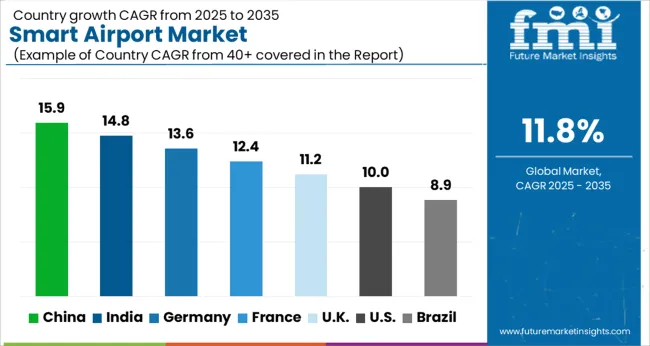
| Country | CAGR |
|---|---|
| China | 15.9% |
| India | 14.8% |
| Germany | 13.6% |
| France | 12.4% |
| UK | 11.2% |
| USA | 10.0% |
| Brazil | 8.9% |
The smart airport market is projected to grow at a global CAGR of 11.8% through 2035, driven by rising passenger traffic, adoption of advanced airport technologies, and increasing focus on automation and security. China leads at 15.9%, a 1.35× multiple over the global benchmark, supported by BRICS-driven expansion in airport infrastructure, integration of AI and IoT solutions, and smart terminal development. India follows at 14.8%, a 1.25× multiple of the global rate, reflecting modernization of existing airports, adoption of automated systems, and increased passenger flow management. Germany records 13.6%, a 1.15× multiple of the benchmark, shaped by OECD-backed innovation in digital airport systems, passenger experience enhancements, and operational efficiency programs. The United Kingdom posts 11.2%, 0.95× the global rate, with adoption concentrated in commercial airport upgrades, technology retrofits, and smart security systems. The United States stands at 10.0%, 0.85× the benchmark, with steady uptake in airport automation, passenger management systems, and operational efficiency initiatives. BRICS economies drive most of the market volume, OECD countries emphasize technological innovation and operational optimization, while ASEAN nations contribute through expanding airport infrastructure and digital system adoption.
The smart airport market in China is projected to grow at a CAGR of 15.9%, driven by large-scale airport modernization projects, increasing passenger traffic, and adoption of automation technologies. Domestic suppliers such as AVIC and China National Aero-Technology provide AI-powered check-in kiosks, biometric boarding systems, and IoT-enabled baggage handling solutions. Technological developments emphasize passenger flow optimization, real-time monitoring, and predictive maintenance. Growth is further supported by government initiatives promoting smart city integration and digital airport operations.
The smart airport market in India is expected to grow at a CAGR of 14.8%, supported by modernization of major airports, rising international travel, and investment in automation and digital infrastructure. Key suppliers such as Larsen & Toubro and Honeywell provide integrated smart airport solutions including automated check-in, security screening, and baggage handling systems. Technological innovation emphasizes real-time analytics, passenger experience enhancement, and operational efficiency. Adoption is concentrated in metropolitan airports while regional airports are gradually upgrading to smart systems.

Germany’s smart airport market is projected to grow at a CAGR of 13.6%, influenced by modernized infrastructure, high passenger volumes, and regulatory compliance for airport operations. Suppliers such as Siemens and Fraport AG provide AI-powered monitoring, automated boarding, and IoT-based baggage management solutions. Technological focus includes enhanced passenger experience, predictive maintenance, and energy efficiency. Demand is concentrated in major international hubs while regional airports are increasingly adopting automation technologies.
The smart airport market in the United Kingdom is expected to grow at a CAGR of 11.2%, driven by modernization of major airports, adoption of automation, and growing passenger volumes. Suppliers focus on AI-driven check-in systems, biometric boarding, and smart baggage handling. Technological adoption emphasizes energy efficiency, passenger flow optimization, and predictive maintenance. Implementation is concentrated in major airports such as Heathrow, Gatwick, and Manchester.
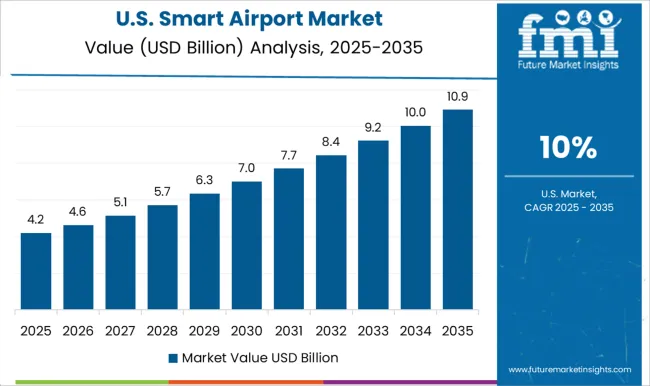
The smart airport market in the United States is projected to grow at a CAGR of 10.0%, supported by modernization of international and regional airports, increased passenger traffic, and adoption of AI-enabled automation. Major suppliers such as Honeywell, Raytheon, and Verifone provide integrated solutions including smart check-in, baggage handling, and passenger flow management. Technological improvements emphasize operational efficiency, real-time monitoring, and enhanced passenger experience.
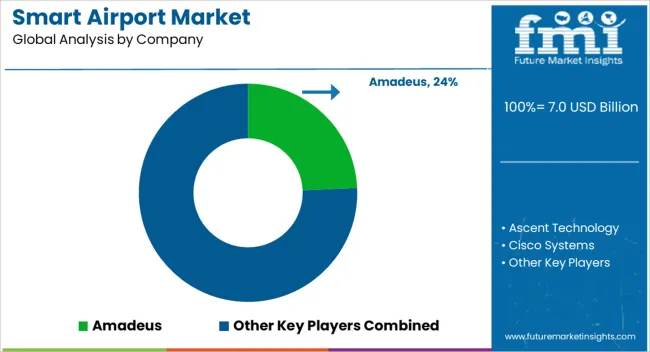
Competition in the smart airport market is being shaped by automation, data integration, and passenger experience enhancement, with companies focusing on advanced technologies for terminal operations, baggage handling, security, and air traffic management. Market positions are being reinforced through connected systems, cloud-based platforms, and global service networks that ensure operational efficiency, safety, and real-time information flow. Amadeus and Ascent Technology are being represented with integrated passenger processing and airline management solutions engineered for seamless check-in, boarding, and flight coordination. Cisco Systems and Huawei Technologies are being promoted with network infrastructure and IoT platforms structured for secure connectivity, data analytics, and smart facility management. Daifuku and IBM are being applied with baggage handling and operational analytics solutions optimized for speed, reliability, and scalability. L3Harris Technologies, Leidos, and NATS are being showcased with air traffic control, surveillance, and navigation systems designed for real-time decision support and situational awareness. Raytheon Technologies, Sabre, Siemens, and SITA are being advanced with end-to-end airport automation solutions structured for efficiency, safety, and interoperability. T-Systems, Thales, and Wipro are being represented with digital solutions engineered for predictive maintenance, resource management, and integrated airport operations. Strategies in the market are being centered on technology integration, operational intelligence, and passenger-centric services. Research and development are being allocated to enhance automation, sensor networks, AI-driven analytics, and cybersecurity. Product brochures are being structured with specifications covering system capabilities, platform compatibility, data handling, and deployment requirements. Features such as real-time monitoring, automated workflow management, predictive analytics, and secure communication are being emphasized to guide procurement and implementation. Each brochure is being arranged to present technical performance, compliance with aviation standards, and support services. Information is being provided in a clear, evaluation-ready format to assist airport operators, technology integrators, and procurement teams in selecting smart airport solutions that meet efficiency, safety, and operational requirements.
| Item | Value |
|---|---|
| Quantitative Units | USD 7.0 Billion |
| Airport Size | Large, Small, and Medium |
| System | Software and solutions, Communication and connectivity, Endpoint devices, and Data Storage |
| Airport Model | Airport 4.0, Airport 2.0, and Airport 3.0 |
| Operation | Aeronautical and Non-Aeronautical |
| End User | Implementation and Upgrades and services |
| Application | Terminal side, Landside, and Airside |
| Regions Covered | North America, Europe, Asia-Pacific, Latin America, Middle East & Africa |
| Country Covered | United States, Canada, Germany, France, United Kingdom, China, Japan, India, Brazil, South Africa |
| Key Companies Profiled | Amadeus, Ascent Technology, Cisco Systems, Daifuku, Huawei Technologies, IBM, L3Harris Technologies, Leidos, NATS, Raytheon Technologies, Sabre, Siemens, SITA, T-Systems, Thales, and Wipro |
| Additional Attributes | Dollar sales by technology type and airport application, demand dynamics across passenger processing, baggage handling, and security, regional trends in airport modernization, innovation in automation, AI, IoT, and biometrics, environmental impact of energy use and e-waste, and emerging use cases in predictive maintenance and seamless passenger experience. |
The global smart airport market is estimated to be valued at USD 7.0 billion in 2025.
The market size for the smart airport market is projected to reach USD 21.5 billion by 2035.
The smart airport market is expected to grow at a 11.8% CAGR between 2025 and 2035.
The key product types in smart airport market are large, small and medium.
In terms of system, software and solutions segment to command 42.6% share in the smart airport market in 2025.






Our Research Products

The "Full Research Suite" delivers actionable market intel, deep dives on markets or technologies, so clients act faster, cut risk, and unlock growth.

The Leaderboard benchmarks and ranks top vendors, classifying them as Established Leaders, Leading Challengers, or Disruptors & Challengers.

Locates where complements amplify value and substitutes erode it, forecasting net impact by horizon

We deliver granular, decision-grade intel: market sizing, 5-year forecasts, pricing, adoption, usage, revenue, and operational KPIs—plus competitor tracking, regulation, and value chains—across 60 countries broadly.

Spot the shifts before they hit your P&L. We track inflection points, adoption curves, pricing moves, and ecosystem plays to show where demand is heading, why it is changing, and what to do next across high-growth markets and disruptive tech

Real-time reads of user behavior. We track shifting priorities, perceptions of today’s and next-gen services, and provider experience, then pace how fast tech moves from trial to adoption, blending buyer, consumer, and channel inputs with social signals (#WhySwitch, #UX).

Partner with our analyst team to build a custom report designed around your business priorities. From analysing market trends to assessing competitors or crafting bespoke datasets, we tailor insights to your needs.
Supplier Intelligence
Discovery & Profiling
Capacity & Footprint
Performance & Risk
Compliance & Governance
Commercial Readiness
Who Supplies Whom
Scorecards & Shortlists
Playbooks & Docs
Category Intelligence
Definition & Scope
Demand & Use Cases
Cost Drivers
Market Structure
Supply Chain Map
Trade & Policy
Operating Norms
Deliverables
Buyer Intelligence
Account Basics
Spend & Scope
Procurement Model
Vendor Requirements
Terms & Policies
Entry Strategy
Pain Points & Triggers
Outputs
Pricing Analysis
Benchmarks
Trends
Should-Cost
Indexation
Landed Cost
Commercial Terms
Deliverables
Brand Analysis
Positioning & Value Prop
Share & Presence
Customer Evidence
Go-to-Market
Digital & Reputation
Compliance & Trust
KPIs & Gaps
Outputs
Full Research Suite comprises of:
Market outlook & trends analysis
Interviews & case studies
Strategic recommendations
Vendor profiles & capabilities analysis
5-year forecasts
8 regions and 60+ country-level data splits
Market segment data splits
12 months of continuous data updates
DELIVERED AS:
PDF EXCEL ONLINE
Smart Meeting Pod Market Size and Share Forecast Outlook 2025 to 2035
Smart Electrogastrogram Recorder Market Size and Share Forecast Outlook 2025 to 2035
Smart Aerial Work Robots Market Size and Share Forecast Outlook 2025 to 2035
Smart Bladder Scanner Market Size and Share Forecast Outlook 2025 to 2035
Smart School Bus Platform Market Size and Share Forecast Outlook 2025 to 2035
Smart Home Wireless Smoke Detector Market Size and Share Forecast Outlook 2025 to 2035
Smart Bus Platform Market Size and Share Forecast Outlook 2025 to 2035
Smart Vision Processing Chips Market Size and Share Forecast Outlook 2025 to 2035
Smart Touch Screen Scale Market Size and Share Forecast Outlook 2025 to 2035
Smart Magnetic Drive Conveyor System Market Size and Share Forecast Outlook 2025 to 2035
Smart Wheelchair market Size and Share Forecast Outlook 2025 to 2035
Smart Mining Technologies Market Size and Share Forecast Outlook 2025 to 2035
Smart Parking Market Size and Share Forecast Outlook 2025 to 2035
Smart Digital Valve Positioner Market Forecast and Outlook 2025 to 2035
Smart Card IC Market Size and Share Forecast Outlook 2025 to 2035
Smart-Tag Inlay Inserters Market Analysis - Size and Share Forecast Outlook 2025 to 2035
Smart TV Market Forecast and Outlook 2025 to 2035
Airport Ground Transportation Market Forecast and Outlook 2025 to 2035
Smart/AI Toy Market Size and Share Forecast Outlook 2025 to 2035
Smart Locks Market Size and Share Forecast Outlook 2025 to 2035

Thank you!
You will receive an email from our Business Development Manager. Please be sure to check your SPAM/JUNK folder too.
Chat With
MaRIA